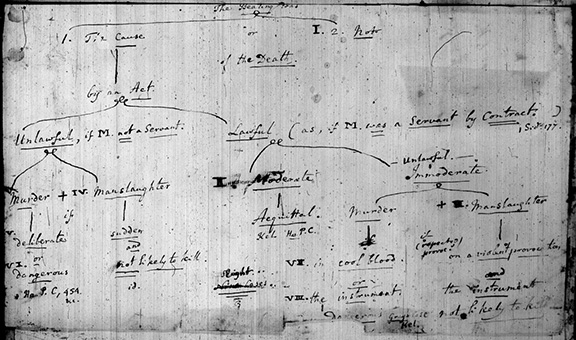Rex v Humphrey Sturt
Summary
Humphrey Sturt, an English gentleman and company writer, took a hunting trip in Bahar. Returning from a successful boar hunt, Sturt brought the boar to his cook, who told him that a slave boy had run away. Sturt blamed Munsa, a Chokeydar (watchman), a worker on loan from another employer. Sturt ordered that he be tied to a tree and beat with bamboo slips to make him confess. When the others did not beat hard enough, Sturt demonstrated a harsher technique. The beating went on all day. The boy was not found and Munsa died.
The trial began on a Thursday, June 16th, 1785 at 9am, and lasted through the night until 4pm on Friday. The judges present were Sir Robert Chambers, Justice Hyde, and Sir William Jones. There were twenty-two grand jurors. The prosecution argued Mr.Sturt ordered the beating of Munsa with bamboo sticks, as well as beat Munsa himself, and was directly responsible for his death. Mr. Sturt pled not guilty of the charges. His defense team of four attorneys argued that this case was an example of natives trying to punish an Englishman unjustly. They also argued that Mr. Sturt’s part in the beatings did not equate to murder, he had not been the last person to beat Munsa and others had disobeyed his orders regarding Munsa’s treatment.
Many witnesses testified to Munsa’s mistreatment by Sturt and others. Most of them testified that Mr.Sturt abused Munsa harshly and many said he was the last one they saw beat him. However, two surgeons argued they did not believe the described beatings would have been enough to kill a man who was healthy at the start. The jury and justices questioned witnesses as to what was given to Munsa while he was tied up, such as water and food, how this could have affected his condition. The next day, after half an hour of deliberations, the jury found the defendant guilty of manslaughter.
Context within the Court
This was a high-profile case: Sturt had a strong defense team and later, disappointed with the results, published a rebuttal, The defence of Humphrey Sturt; Esquire, on a charge exhibited against him for murder, as delivered by him at his trial before the Supreme Court of Judicature at Calcutta, in Bengal, on Friday, the 17th of June, 1785.
This trial was pivotal in the life of the court itself, as seen from the notebooks. It was the first case where Sir Robert Chambers wrote extensively and it was the first trial in the notebooks with handwriting from all the judges. After this turning point in 1785 (with both Chief Justice Impey and Governor General Warren Hastings gone), Chambers became the chief scribe and eventually Chief Justice.
This case is also an example of how frustrating the notebooks can be. The trial testimony lasted over thirty hours with the judges often writing as fast as they could to keep up. Chambers has trouble keeping ink in his pen so some pages are too faint to read. They may have temporarily run out of blotting paper because on some pages the ink spread, making it hard to read.
Testimony may have taken place in Bangla, Hindi/Urdu, Persian/Farsi and English with court interpreters. Some words, such as Chokeydar, Chumar and Khalassy had become cross-cultural, but there was no standardized spelling, so they are spelled in many different ways. The judges wrote down what they heard as they heard it and it makes for difficult reading.
To make this case more manageable for readers, it is split into four sections below. When the judges handed the book from one to another, the change in writers is noted. To see the notebooks pages for the case, they are in June of 1785, images 051 to 284. Below is Hyde’s Summary of the case and the flowchart Jones made for Chambers to help him direct the jury.
(Note: Hyde's writing)
Friday June 17th 1785.
Present
Sir Robert Chambers
Mr. Justice Hyde
and
Sir William Jones
Rex
v
Humphrey Sturt
The Trial of this Indictment continued without Intermission from yesterday. The Trial lasted untill about Four or Five o’Clock, when the jury brought in their Verdict.
Not Guilty of Murder
Guilty of Man-Slaughter.
The Court pronounced Sentence on the Prisoner to be burnt in the hand and discharged and it was done immediately.
Mr. Humphrey Sturt, came into Court, at about Nine o’Clock with Mr. Hamilton His Attorney, and sate down at the Table among the Advocates by Mr. Hamilton.
The whole panel of the Jury was call’d through but only about 20 appear’d.
Mr. Humphrey Sturt was found Guilty of Man Slaughter.

Figure 1 - Flowchart composed by Sir William Jones for Sir Robert Chambers' use in directing the jury